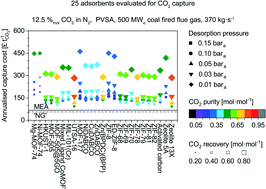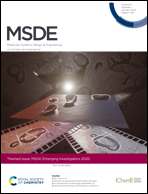Exploring the limits of adsorption-based CO2 capture using MOFs with PVSA – from molecular design to process economics†
Abstract
Metal–organic frameworks (MOFs) have taken the materials science world by storm, with potentials of near infinite possibilities and the panacea for adsorption-based carbon capture. Yet, no pilot-scale (or larger-scale) study exists on MOFs for carbon capture. Beyond material scalability issues, this clear gap between the scientific and engineering literature relates to the absence of suitable and accessible assessment of MOFs in an adsorption process. Here, we have developed a simple adsorbent screening tool with process economics to evaluate adsorbents for post-combustion capture, while also considering factors relevant to industry. Specifically, we have assessed the 25 adsorbents (22 MOFs, 2 zeolites, 1 activated carbon) against performance constraints – i.e. CO2 purity and recovery – and cost. We have considered four different CO2 capture scenarios to represent a range of CO2 inlet concentrations. The cost is compared to that of amine-based solvents for which a corresponding model was developed. Using the model developed, we have conceptually assessed the materials properties and process parameters influencing the purity, recovery and cost in order to design the ‘best’ adsorbent. We have also set-up a tool for readers to screen their own adsorbent. In this contribution, we show that minimal N2 adsorption and moderate enthalpies of adsorption are key in obtaining good process performance and reducing cost. This stands in contrast to the popular approaches of maximizing CO2 capacity or surface area. Of the 22 MOFs evaluated, UTSA-16 shows the best performance and lowest cost for post-combustion capture, having performance in-line with the benchmark, i.e. zeolite 13X. Mg-MOF-74 performs poorly. The cost of using the adsorbents remains overall higher than that of an amine-based absorption process. Ultimately, this study provides specific directions for material scientists to design adsorbents and assess their performance at the process scale. This works intends to bridge the gap between scientific and engineering studies to accelerate CO2 capture adsorbents development. The approach can be extended to other molecular separations.

- This article is part of the themed collections: 2021 MSDE Symposium Collection, Celebrating our 2020 Prize and Award winners and MSDE Emerging Investigators 2020


 Please wait while we load your content...
Please wait while we load your content...